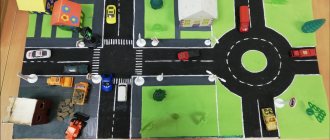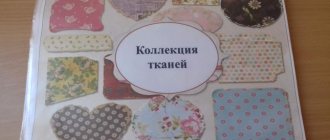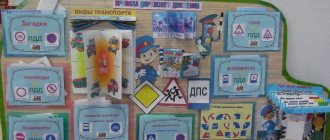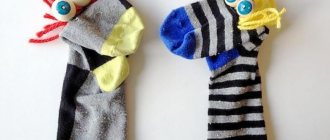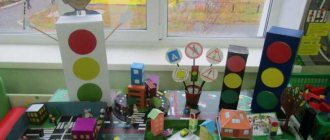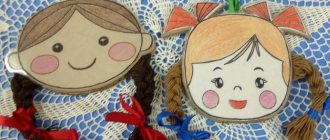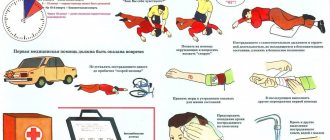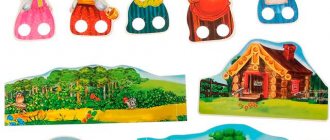Senior group project “Street Layout”
Project “Streets of my city”
for older children
“The homeland for a person is the most precious and sacred thing,
without which a person ceases to be a person"
V.A. Sukhomlinsky
The foundations of patriotism begin to form in preschool age.
The foundation of patriotism is rightfully considered to be the purposeful familiarization of children with their native land. Love for the Fatherland begins with love for one’s small homeland - the place where a person was born.
For the success of working with children to familiarize themselves with the city where they live, I believe that the most effective way is to use the project method. So my senior children and parents and I implemented the “Streets of My City” project, which was based on the creation of a model of the streets where our favorite kindergarten and multidisciplinary gymnasium are located.
And now we will present to your attention our work.
1 slide
1 Child
: Every person has one homeland! Homeland is the place where everything is dear to us, where we were born. Every person has his own homeland. Our homeland is the city of Gorodovikovsk. This is a small, beautiful city.
I love my city. It is beautiful at any time of the year. In summer the city is all green, there are many trees and flower beds. In winter, a huge Christmas tree with Christmas decorations is installed in the center of the square.
There is a park in our city. I like to ride on the carousel in the park in the summer.
Every year our beloved city becomes more and more beautiful.
Every person should love his homeland. I really like my city.
2 slide
. I love my Gorodovikovsk!
Everyone in the world has their own little corner. For me, believe me, this is what our quiet town has become. Before, I didn’t understand and sometimes I was sad if my mother walked us home after kindergarten. We didn't want excursions, We wanted to go on the swing! But now I’m older and my interest has awakened: About my native and glorious city Find out everything, finally. Every day I look forward to when we go for a walk, Because my mother can tell me everything: About sculptures, monuments And about the Victory monument, About athletes, masters, Famous fellow countrymen... I know everything about the city, And now I understand: We should be proud of it, our native city!
3 slide.
2nd child:
There are no cities without history. The history of each city is closely connected with the biography of its streets .
Many streets in our city bear the names of glorious sons of their fatherland, but not everyone knows who they were, how and at what price they earned the right to be immortalized in the names of streets and its monuments.
Today I would like to talk about a street that I often walk along. It is named after the Hero of the Soviet Union Bambi Khicheev.
We visited the museum of the gymnasium named after. B.B. Gorodovikov, where we were told about the hero, about his difficult battle path. Bembya Khicheev was a brave and brave man who loved his homeland very much.
Educator:
Through the Internet we found a relative of Bembya Khicheev, Marina Erentsenovna Sokalskaya. I suggested that the children send a greeting card for the Great Victory Day. The children happily agreed.
In it we wrote that the guys are proud of Bembya Khicheev and want to be like him.
Child:
His awards: The Gold Star Medal was awarded for heroism, boundless devotion and courage in the fight against the Nazi invaders;
· The order of Lenin;
· Order of the Patriotic War, 1st degree.
Educator:
When the guys found out whose name the street we walk along every day bears, we all started a very interesting job together - making a street model. This is very interesting, because every house, every tree now seems even more familiar and special.
4 slide
Educator:
Objective of the project:
Introducing children to the history and culture of their hometown through familiarization with the streets of their immediate surroundings.
Tasks:
1. Instill in children a love for their hometown.
2. Expand children’s understanding of the history of the streets of their hometown, enrich their vocabulary and coherent speech.
3. To form spatial concepts in children, the ability to navigate the streets of their hometown
4. Promote the active involvement of parents in joint activities with the child.
5. Enrich parent-child relationships with the experience of joint activities through the formation of ideas about the streets of their hometown.
6. Teach how to apply the acquired knowledge in practical activities.
5 slide
.
We began our work on the project with a tour of the streets where the kindergarten and multidisciplinary gymnasium are located. This is the street named after Maxim Gorky and Bambi Khicheev. The children and I examined the houses that are located here, learned that they are one-story and two-story, and counted how many houses there are on these streets. We also considered a kindergarten and a gymnasium. We found out that the gymnasium building is the tallest - three floors. They compared it with the houses located on these streets.
6 slide
Then the children in kindergarten began to build houses from the blocks that they saw on the excursion. The guys argued, changed places of houses, remembered and compared with what they saw on the excursion.
7 slide
The next stage of work was to select the material from which our structures will be made. The guys suggested cutting houses out of cardboard, sawing them out of wood, and making them out of clay. There were many options and proposals, but after thinking through all the materials and showing them to the children, it was decided that the houses would look simpler and more believable from foam plastic. It will give volume and the shape required for the layout will appear. So the children repeated working professions - builder, architect, painter. The children got to work.
8 slide
We also involved parents in this work. They gladly responded to our request.
Slide 9
New houses were born in the home environment. House by house, gradually the guys completed all the copies.
10 slide
Then together we began to plan our layout (exhibit houses and institutions). And again the guys had to argue a little and use their memory.
11 slide
Then we started working on the details of the layout: building the road,
12 slide
greening the street - the girls really liked it, they imagined themselves in the place of street designers and fantasized about how else they could decorate our streets.
Slide 13
So we have completed the interesting work on the layout. And this exhibit, made jointly by teachers, children and their parents, will be added to the mini-museum of the “Fairy Tale” kindergarten.
Country yard craft for kindergarten
To create such a model of a village yard, you will need:
- cardboard;
- PVA glue;
- colored paper;
- scissors;
- twigs;
- miniature jigsaw or stationery knife;
- tree branches;
- acorns;
- figurines of village courtyard inhabitants;
- plasticine;
- colored paper;
- hot glue gun;
- cardboard box.
The cardboard box must be cut so that the bottom and the corner of the two walls, as well as themselves, remain. The bottom of the cardboard needs to be peeled off with green paper to create such a beautiful grass. A house will be fixed on one of the walls, and the second and a fragment of the first should be painted. To do this, let the child paint here with blue and white colors the sky with clouds, and when this background dries, depict trees with leaves and green hills on it.
Tell him how to make a house out of colored paper. It needs to be glued onto a rectangular sheet of cardboard, and acorns or hazelnuts should be attached to the side using a hot gun. They will become the ends of the logs.
You need to cut out the frame for the windows from colored cardboard, and make the glass from white colored paper.
Let the child first glue them to the marked places, and then draw pots of flowers here. Now you will need to glue the strips of cardboard so that they turn into frames. The roof for the house is cut out of red cardboard or ordinary gray cardboard, and a triangle of scarlet paper is already glued onto it. The roof can be tiled, then you need to draw wavy lines in a checkerboard pattern with a pencil.
Here's how to proceed with the layout of the village. With your own hands, let the child cut out a rectangle from colored cardboard and fold it in half. To this bench below you need to glue small rolls of cardboard, which will become logs. The bench rests on them.
It's nice to sit on it surrounded by flowers. Your child will create them from colored paper. To be able to admire a small pond, surround it with your child with acorns or nuts, and the child molds the water from plasticine, giving it a semicircular shape.
You can focus on highlights made from plasticine of other colors.
Perhaps it will be a fire pit. Then you can put a few sticks here, which will give the picture more realism.
Make a canopy on the roof, then you can put a toy cat here, attach it with silicone from a hot gun.
There is also a place for other animals. Let the child make a kennel out of cardboard for the dog. It is not difficult to create this structure. You will need to cut two identical walls for the side and two for the back and front of the kennel, with a pointed top. You need to cut a large hole in the front to put the dog here. The roof is created from a rectangle of cardboard, which needs to be bent in half and glued.
The layout of the village will be incomparable if you and your child also create a lake with a bridge. Let your beloved child crush the blue and white plasticine and cover the oval area with it. This water is surrounded by an acorn or nuts glued directly to the plasticine or using a hot gun. Attach the duck and her babies in the same way. The bridge needs to be made of cardboard.
Using cardboard, it is also quite easy to create a stable, and glue pieces of twigs onto the roof, which will turn into a roof.
In the same way, a barn is created where the heifer and foal will live.
To make a sheep pen, you need to cut a wide strip of cardboard and glue it to the clearing, and also glue the ends together to make a circle. Inside you will place sheep. Glue pieces of twigs to the outside of this pen to make the fence look more realistic. Inside you can place an inverted cap from a plastic bottle, into which you need to place food made of green plasticine.
This village layout will accommodate many characters. Pigs will be next. The pen for them is made from twigs glued together.
Using the same material, you and your child can create a stall for a goat. And the roof for it is made in a very interesting way. To do this, you need to glue twigs onto an old CD, and on top of them? hazelnuts. Using these same gifts of nature, you can decorate the cardboard walls of the building so that they look like logs.
The child will be happy to fashion bowls from plasticine and place them next to the animals.
All that remains is to make some small accessories:
- Make firewood from wine corks, which need to be cut lengthwise into 4 parts with a stationery knife and painted in the appropriate color.
- It is also used to make a spinner for a well. You will need to make holes in the wine cork with an awl, insert a wooden skewer and wind the thread. A shampoo cap is attached to the rope below, which acts as a bucket.
- And the well itself was made from a bottle of Agusha yogurt. You need to cut out the side walls, leaving only one vertical post on both sides.
- A spit for the well is attached to them, and its roof is made from a bag taken from thermal milk. Now all that remains is to paint these masterpieces and admire the results of the work.
Who knows, maybe your child, when he grows up, will want to recreate such a model of the village, but more realistic. We invite you to familiarize yourself with one of these projects, which was created in England.
English village model
Here is a small copy of the village of Bourton-on-Water on a scale of 1:9. The houses are made of the same material as the original. The craftsmen did their best, because they even made shop windows and signs, just like in that real village.
The streets here are quite spacious so that visitors can walk freely and admire this layout of the village.
The gardeners here also work hard.
After all, ordinary trees near such buildings will look too tall. Therefore, low bonsai were used. They are periodically pruned to resemble real trees. The lawns are made in the English style and also require periodic maintenance. They are watered, fed, trimmed.
Do you think that only professionals can build such miniatures? No, if desired, people without special construction or architectural education can do this. You will see this now.
